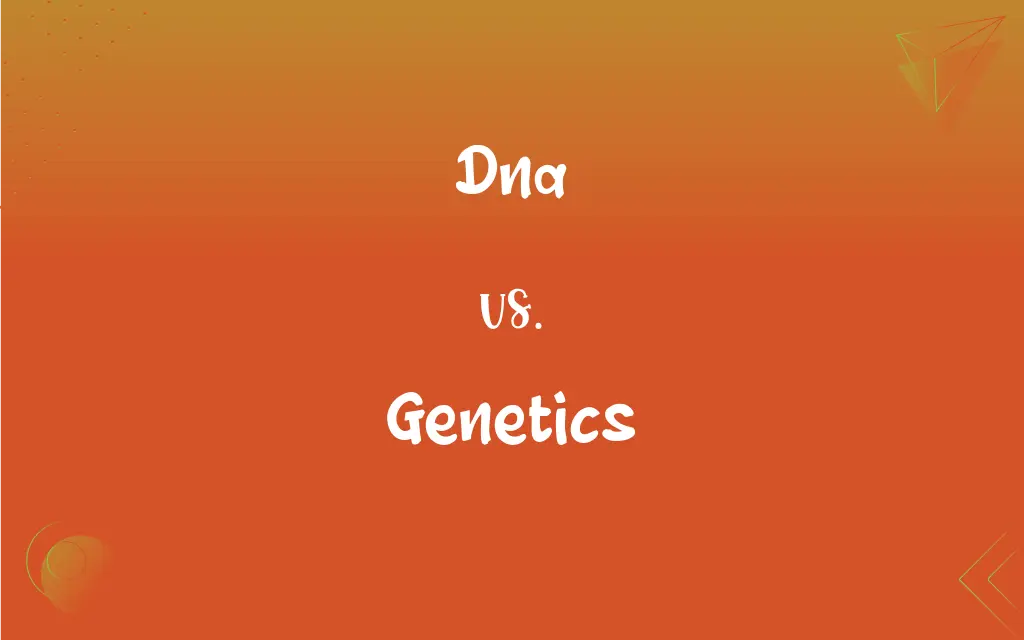DNA vs. Genetics: What's the Difference?
Edited by Aimie Carlson || By Harlon Moss || Updated on October 28, 2023
DNA is the molecule containing genetic instructions, while genetics is the study of heredity and variation in living organisms.

Key Differences
DNA, or deoxyribonucleic acid, is a molecule that carries the genetic instructions used in the growth, development, and functioning of all known living organisms. Genetics, on the other hand, is the field of biology that studies genes, heredity, and genetic variation in living organisms.
In every cell, DNA is the material that carries the information about an organism's traits, passed from one generation to the next. Genetics is the scientific exploration of how these traits are inherited, how genes are expressed, and how genetic information is replicated and passed on.
DNA is structured as a double helix composed of nucleotides, and its segments called genes are responsible for specific traits. Genetics encompasses not just the study of genes, but also the analysis of gene function, variation, and distribution among populations.
DNA is essentially the biological blueprint within a cell, while genetics is the broader study that explores how these blueprints lead to observable characteristics, or phenotypes. DNA is the substance, and genetics is the science that seeks to understand how that substance works within the context of living organisms.
Comparison Chart
Definition
Molecule with genetic instructions.
Study of heredity and genetic variation.
ADVERTISEMENT
Function
Carries genetic information.
Analyzes inheritance patterns.
Composition
Double helix of nucleotides.
Broad field, includes molecular biology, epigenetics.
Role
Biological blueprint for traits.
Scientific understanding of gene function and inheritance.
Application
Found in every cell.
Applied in fields like medicine, agriculture.
DNA and Genetics Definitions
Dna
Blueprint for biological traits and functions.
Mutations in DNA can lead to genetic disorders.
ADVERTISEMENT
Genetics
Science analyzing genetic variation and inheritance.
Genetics is crucial in breeding better crops.
Dna
Double helix structure storing genetic information.
DNA replication is essential for cell division.
Genetics
The study of heredity and gene function.
Genetics explains why siblings have similar traits.
Dna
Carrier of hereditary information in cells.
DNA from parents influences a child's appearance.
Genetics
The field exploring genetic disorders and traits.
Genetics helps understand inherited diseases.
Dna
Molecule containing an organism's genetic code.
DNA tests can reveal your ancestry.
Genetics
Study of how genes are transmitted across generations.
Genetics research has advanced cancer treatment.
Dna
The molecular basis of genetic inheritance.
DNA fingerprinting is used in forensic science.
Genetics
Discipline examining DNA's role in heredity.
Personalized medicine often relies on genetics.
Dna
A nucleic acid that carries the genetic information in cells and some viruses, consisting of two long chains of nucleotides twisted into a double helix and joined by hydrogen bonds between the complementary bases adenine and thymine or cytosine and guanine. DNA sequences are replicated by the cell prior to cell division and may include genes, intergenic spacers, and regions that bind to regulatory proteins.
Genetics
(used with a sing. verb) The branch of biology that deals with heredity, especially the mechanisms of hereditary transmission and the variation of inherited characteristics among similar or related organisms.
FAQs
Can DNA change over time?
Yes, mutations can alter DNA sequences.
What does genetics study?
Genetics studies heredity and genetic variation.
How is DNA structured?
DNA has a double helix structure made of nucleotides.
What is DNA?
DNA is the molecule that carries genetic instructions in cells.
What role does DNA play in cell function?
It contains instructions for building proteins.
What are genes in genetics?
Genes are DNA segments that determine traits.
How do genetics affect health?
Genetic makeup can influence susceptibility to diseases.
What is genetic inheritance?
It's the passing of genes from parents to offspring.
Do identical twins have identical DNA?
Yes, they usually have almost identical DNA.
How do environmental factors influence genetics?
They can affect gene expression and lead to mutations.
Is DNA replication important?
Yes, it's crucial for growth and repair.
What's genetic diversity?
It's the variety of genetic differences within a population.
How is DNA used in forensics?
DNA profiling can identify individuals in criminal cases.
Can lifestyle impact genetics?
It can influence gene expression, known as epigenetics.
Are genetic disorders curable?
Some can be managed or treated, but not all are curable.
What's the role of DNA in heredity?
It carries traits passed from parents to offspring.
Is DNA found in all living organisms?
Yes, all organisms have DNA.
How has genetics advanced medicine?
It's led to personalized treatments and better disease understanding.
Can genetics predict diseases?
Genetics can indicate predisposition to certain diseases.
What's a genetic mutation?
A change in the DNA sequence.
About Author
Written by
Harlon MossHarlon is a seasoned quality moderator and accomplished content writer for Difference Wiki. An alumnus of the prestigious University of California, he earned his degree in Computer Science. Leveraging his academic background, Harlon brings a meticulous and informed perspective to his work, ensuring content accuracy and excellence.
Edited by
Aimie CarlsonAimie Carlson, holding a master's degree in English literature, is a fervent English language enthusiast. She lends her writing talents to Difference Wiki, a prominent website that specializes in comparisons, offering readers insightful analyses that both captivate and inform.































































